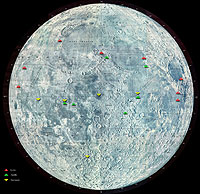Our universe and her near neighbours
Let’s take a look at the planet earth’s Polar Regions where the global warming is currently melting down thousands of ice blocks and increasing the volume of liquid water on the earth surface. Polar Regions receive less intensive solar radiation because the sun’s energy arrives at an oblique angle, spreading over a larger area, and also travels a longer distance through the Earth’s atmosphere in which it may be absorbed, scattered or reflected, which is the same thing that causes winters to be colder than the rest of the year in temperate areas.

Earth’s moon image.
